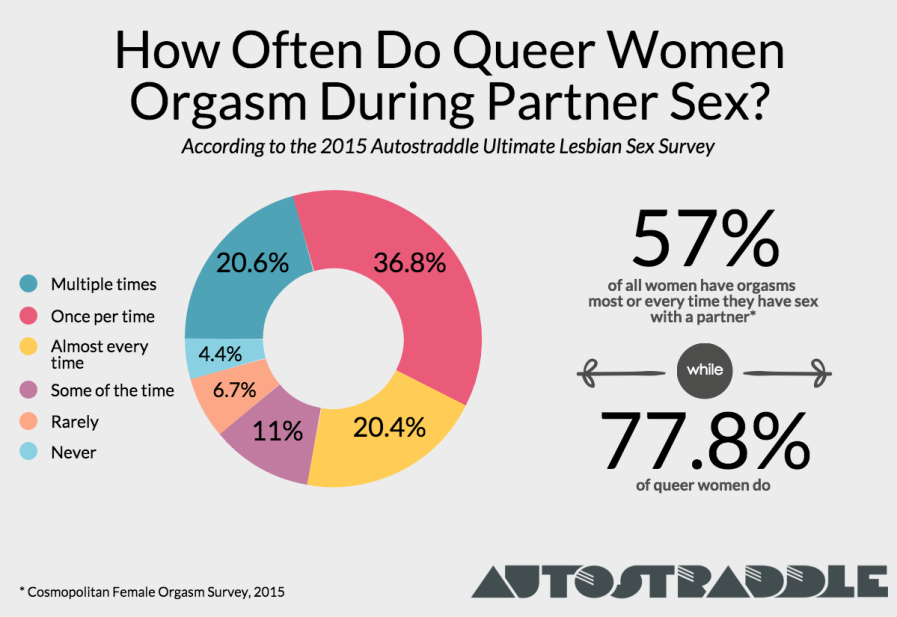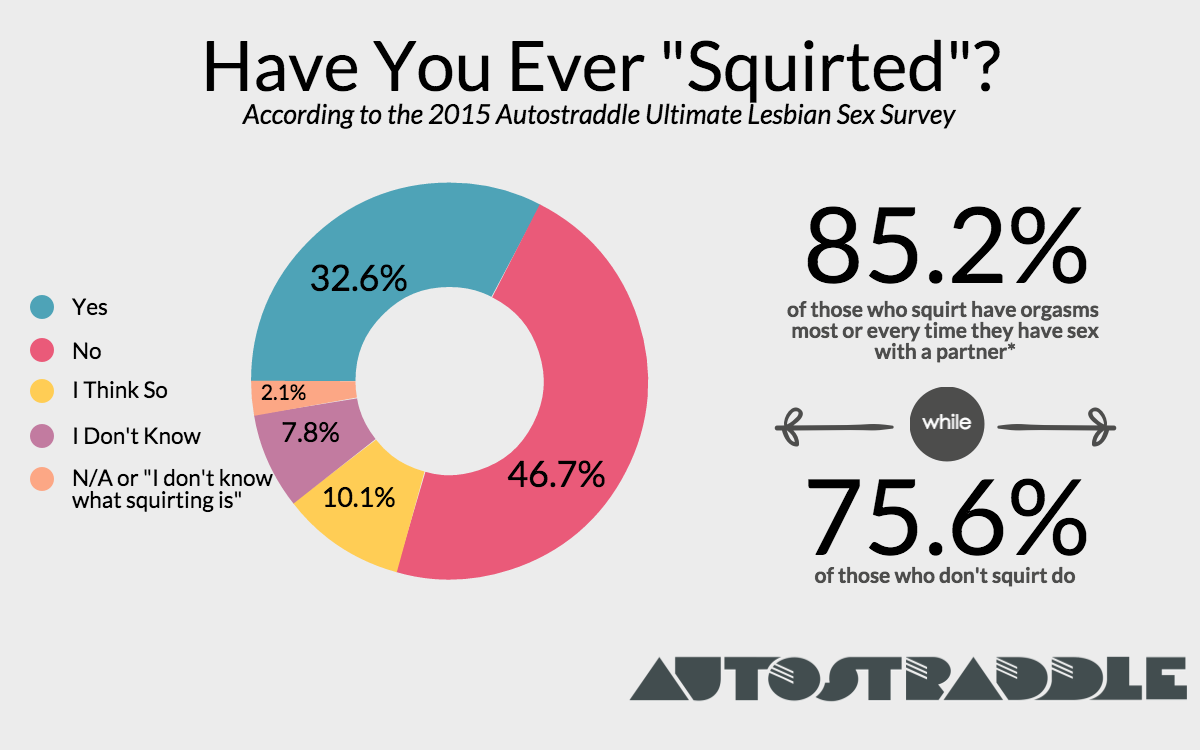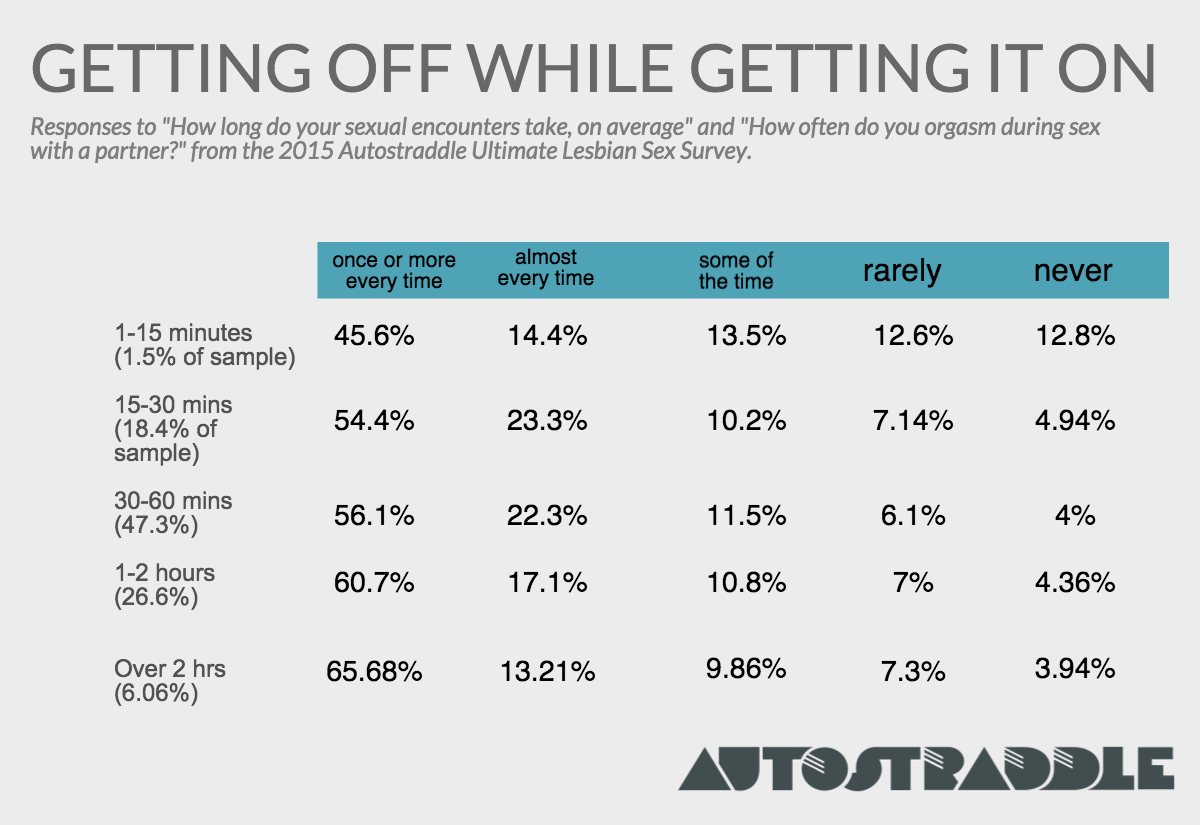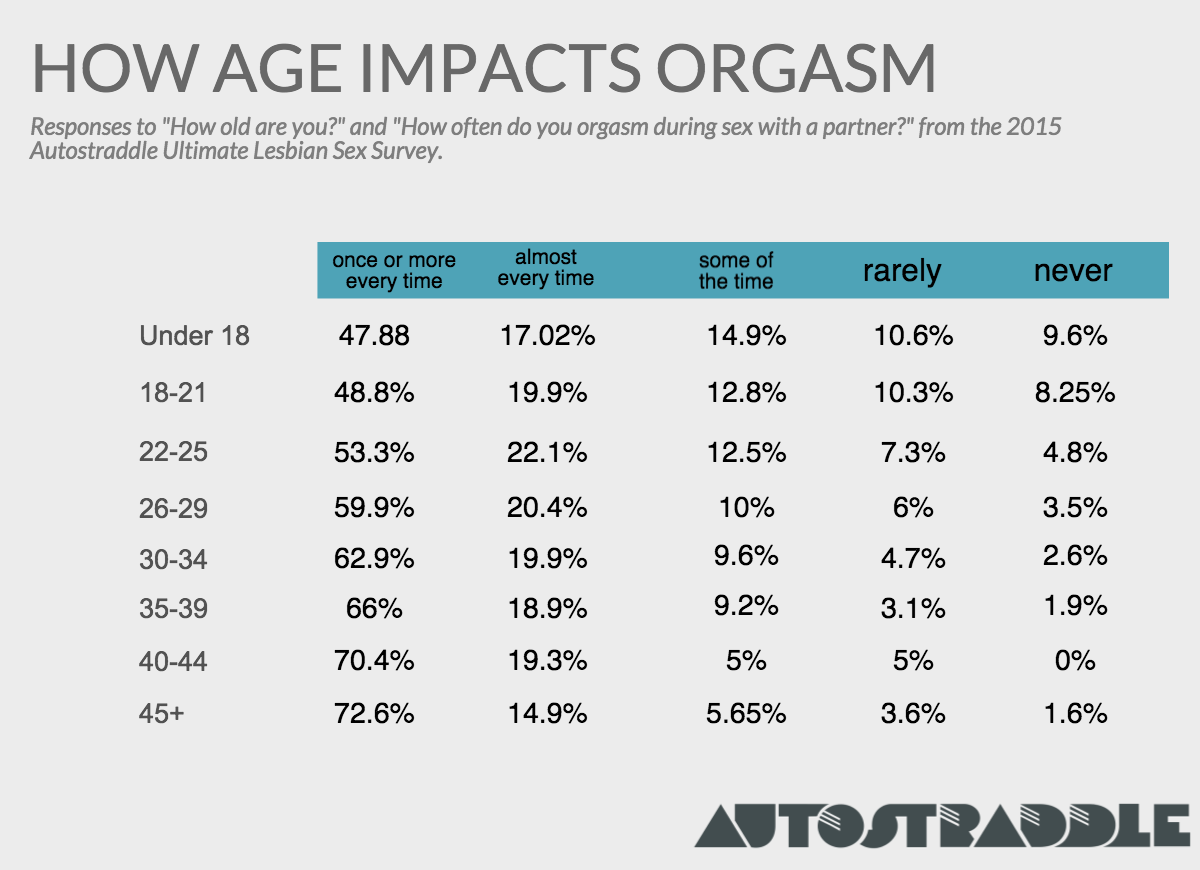In February 2015, Autostraddle launched The Ultimate Lesbian Sex Survey, open to all “lady-types who sleep with lady-types.” We garnered over 8,566 complete responses (89% of which were from people between the ages of 18 and 36) and now we’re sharing the results with you, bit by bit. Previously: How Often Do Queer Women Have Sex?, 100 Gayest Places You’ve Had Sex, The Masturbation Habits of Queer Women, 50 Really Fascinating Things You Wanted Us To Know About How You Have Sex, 26 Bits of Solid Sex Advice, 41 Feelings You Have About Scissoring and Here Are Your Very Queer Underwear-Wearing Habits. Today we’re talking about orgasms!
Orgasms: many women consider them integral to the sexual experience, others consider them an afterthought, some struggle to have them, some struggle not to have them. Oh, and lesbians have more of them than straight women.
I knew that much before we did our research, though. It was big news last year when The Kinsey Institute found the following:
Heterosexual men and gay men both experience orgasm about 85 percent of the time. Heterosexual women reach orgasm at a rate of almost 62 percent, while for lesbian women, orgasm occurs nearly 75 percent of the time. Bisexual people reach orgasm at the lowest rate for each gender, at 58 percent for bisexual women and about 78 percent for bisexual men.
In our article about the study, Mari noted:
About 13% of bisexual women reported never being able to orgasm with familiar partner, and 7.5% of heterosexual women reported the same. However, for lesbians, that number drops to a minuscule 2.2%, meaning that nearly 98% of lesbians are getting a big O, at least occasionally, from their partners.
There’s no way to directly compare their numbers to ours, because we didn’t assign numerical values to frequency of orgasm and we also approached the question from a different angle. However, although most other data on straight couples is focused on whether or not the woman has a vaginal orgasm, Cosmo recently did a Female Orgasm Survey of 2,300 women between the ages of 18 and 40 and found only 57% of women having orgasms of any kind most or every time they have sex with a partner. When you compare that data to our data, queer women still come out on top.
So let’s look at our data — but first, some important things to know as you look at this data with us: we asked survey takers to report how often they usually orgasmed during sex and the response choices were: multiple times, at least once per time, almost every time, some of the time, rarely, never and N/A (which we assumed would be chosen mostly by people who’ve never had sex or who aren’t sexually active right now). We removed the N/As from the sample for this investigation, leaving us with 8,367 complete responses to analyze.
Also, pay attention to exact language as you read this post because sometimes we group the data by “those who orgasm at least once every time” and sometimes we look at “those who orgasm almost every time or more.” The former contains those who responded with “multiple times” or “at least once per time,” the latter contains those groups as well as those who said “almost every time.”
Secondly, a disclaimer: orgasms are not essential aspects of sex for everybody, and we’re not arguing that it they are. Sex can be glorious without orgasms, and often focusing too much on climax can make sex less enjoyable. It’s never safe to assume that your partner needs to climax to enjoy sex, or vice versa!
Alright, let’s begin!
How Often Do Y’all Orgasm During Sex?

We’re comparing ourselves to the Cosmo survey ’cause it appeared to approach the question from the same angle and, like ours, was a survey of readers who were probably more interested in sex than the average bear. But it bears mentioning that other studies have shown lower numbers for straight women, like a 1994 University of Chicago study that reported 29% of women always having orgasms with their partner.
We also wanted to know about rates of female ejaculation, which The Frisky describes as being “the unicorn of sexual experiences” that most women “have only dreamed of meeting it face to face.” The Frisky also notes the lack of research on the topic, finding that “percentages of women who report that they have at some time experienced the gushing of fluid during orgasm range from six percent to 60 percent depending on the study.” Here’s what we found:

Timing Is Everything
Three factors have the biggest impact on orgasmic frequency; the first is how long you spend having sex.
80% of y’all have sex for 30 minutes or more, which far exceeds reports on how long straight couples have sex. A 2005 study of 1,500 couples clocked the average lovemaking session in at 7.3 minutes and a 2012 Durex study of 1,000 adults found an average of ten minutes and 50 percent of the sample “saying they weren’t happy with the duration (or lack thereof) they are experiencing in their sex lives.” Indeed, this short duration is often blamed for why women often don’t orgasm during heterosexual sex. However, “lovemaking session” is defined in a really limited and patriarchal way, as “the length of time from penetration to ejaculation.” So, there’s that.
Only 18 of our survey-takers reported lovemaking sessions of six or more hours, which is too small of a sample for statistically significant results. However, it seems these 18 humans might be into some tantra, ’cause 61.11% of them have multiple orgasms every time they have sex!
Now for the statistically significant results:

As you can see, the most dramatic differences are on either end of the spectrum — those who never orgasm and those who always do — and the numbers for “sometimes” and “rarely” turn out pretty randomly. 30-60 minutes seems to be the minimum time put in to increase likelihood of orgasm.
Relationship Status
The second most important factor: your relationship status. The closer you are with your partner, the more likely you are to orgasm while having sex with them.
Single sex is wild and random, in my experience: maybe it’s a quickie in the bathroom or maybe it’s one of those drunken one-night stands where — mutually aware of the one-night-only nature of the encounter — you try to devour as much of each other as you possibly can for hours and hours and hours and then feel like shit at work the next day. For some, those marathons can be orgasmless and for others, nothing gets them off quicker than a quickie with a stranger. We’re all different special snowflakes.
Because here’s the thing: women are complicated! Once upon a time I was a proudly promiscuous girl who thought she was straight and, honestly, most of the hookups I had with men were pretty similar in content to one another. That’s definitely not been the case with women. There’s so much variety! Everybody is so different than everybody else! There’s so much to learn with each new partner! This is a challenge for men sleeping with women, too: women rarely orgasm during one-night stands with men (I never did).
The data reflects the uncertainty women and genderqueer folks feel with new partners — 65.7% of monogamous folks in relationships have orgasms once or more every time, compared to 50.4% of the non-monogamous and 44.14% of single people. This makes sense: single people and non-monogamous people are more likely than monogamous people to sleep with a new partner or to have lovers they’re not deeply involved with.

The longer you’ve been in your relationship, the more likely you are to orgasm, too. So, although people in younger relationships are having more sex, they’re less likely to be coming from it. 85.6% of those in monogamous relationships between 1-3 years long have an orgasm almost every time or more, compared to 76.2% who’ve been with their partners for six months or less. 5.48% of brand-new relationships never get you off, whereas the numbers for all other relationship lengths are between 1 and 2.5 percent.
Orgasmic frequency seems to be related to how happy you are in your relationship, too. Of respondents in monogamous relationships, 87% of those who are happy or ecstatic orgasmed at least every time or more, compared to 69% of those who were unhappy, miserable, or wanted to break up and 77% who felt “neutral” or “kinda happy” about their relationship.
The Age Factor
Now, the third most important factor: age. Just like with straight women, how old you are has a major impact on your orgasmic situation. Although queer women masturbate more than straight women, it still can take more time for us to grow into our bodies and discover what turns us on and gets us off during partner sex. Queer people often suppress their sexual desires, hoping to avoid the homosexual plague, leading to shame and guilt that can easily block orgasm. Others are dogged by gender dysphoria or a sense that their bodies are undesirable by normative gender standards. So much of the female orgasm is psychological that the deck is really stacked against us. AND YET.

The differences of orgasmic frequency between 18-21 year olds and 22-25-year-olds is significant, but not huge. As we climb the age beanstalk a bit higher into the sky, big changes result, even amongst women who are probably post-menopausal. This could not possibly make more sense: the longer we’re alive, the more time we’ve had to figure out what turns us on.
So, those are the three most important factors, but there’s many more interesting correlations left to discuss!
Sexual Orientation
Lesbians were the most orgasmic of all sexual orientation groups. 61% orgasmed once or more during partner sex, compared to around 51% of queer-identified folks and bisexuals.
These numbers are more extreme when you filter out single folks — a whopping 25.12% of lesbians in relationships have multiple orgasms every time they have sex, and 43.4% have at least one, for a grand total of 68.5% clocking an O every time. There’s a huge leap for bisexual folks in relationships, too: 60.4% have orgasms every time. Just 2.8% of bisexuals and 2.07% of lesbians in relationships never have orgasms during sex.
141 queer-identified women who’d had sex with men but never with women answered the survey, which is a very small sample. But even that small sample reflected what statistics on the general population have also revealed: sex between women gets women off more frequently than different-gender sex does. Of the 141, 32.6% orgasm once or more during sex — much lower than the 56% – 58% reported by those who have had sex with women. When you add those who come “almost every time,” the difference remains stark — about half of the humans who’ve only slept with boys orgasm almost every time or more, opposed to 76.2% of gold stars and 78% of those who’ve had sex with men and women.
Gender
Agender folks are all-around winners in the race to orgasm. 84.1% of agender folks orgasm “almost every time” or more, compared to 78.5% of cis women, 75.6% of genderqueer folks and 60.6% of trans women. There wasn’t much variation on the “never” side — all gender identities were equally likely to never orgasm (around 4.5%). Trans women were much more likely to rarely or sometimes orgasm — 21.2% sometimes do, compared to between 10 and 13 percent of cis and genderqueer folks, and 13.4% rarely do, compared to around 6.5% of cis and genderqueer folks. This could be due to a number of factors: a lack of resources about lesbian sex for trans women, gender dysphoria, and the effects of hormone treatment. Many theorize that women get each other off better than men do because of our intimate knowledge of our own bodies, but that really only applies to cis women having sex with other cis women — and these numbers reveal that there needs to be more information out there and more discussion of sex with trans women.
The data on gender presentation reveals that high femmes, hard femmes and stud/AGs are the most likely to have multiple orgasms. Baby butches are the most likely not to orgasm during sex (9.6% don’t), which is likely age-related. Although Stud/AGs are the most likely to report multiple orgasms during sex (30.8%), they’re also the second-most likely to report never orgasming during sex (6.7%). A lot of the “middle ground” identities, like something-of-centers and tomboy femmes, all come out with similar numbers.
The least likely to report never orgasming? Butches and high femmes.
Masturbation
The less often somebody reported that they masturbate, the more likely they were to report never or rarely orgasming during sex. However, there isn’t a major link between masturbating a lot and orgasming every time during sex. This suggests a certain threshold — whether you’re rubbing one out once a month or once a day, you’re still just as likely to get off during sex.
Number of Partners
The more female sexual partners a person has had, the more likely they are to report orgasming during sex almost every time or more. Multiple orgasms were much higher for those with more partners, too — 16.2% of those with 1-2 partners have multiple orgasms every time, compared to around 35% of those with 50 partners or more. However, again: correlation isn’t necessarily causation. Perhaps the more orgasms you have during sex, the more likely you are to be a person who seeks out more sex and more sexual partners.
Frequency of Sex
Often people who orgasm more want to have sex more: 62.74% of those who want to have sex once a day orgasm every time, compared to 44.9% of those who want to have sex multiple times a month.
So, are couples who orgasm more happier with their sex lives?
Yes, there is some correlation there. 76% of those in relationships who get off once or more per sexual encounter are either very or mostly satisfied with their sex lives, compared to 54% of those in relationships who “rarely” or “some of the time” do. But still; 54% is an enormous number of people who are happy regardless of orgasmic frequency. I mean, 47% of people in relationships who are dissatisfied with their sex lives orgasm at least once every time they have sex. It seems like frequent orgasms might enhance or be products of an already-great sex life but definitely won’t salvage or define one.
Other factors linked to high orgasmic frequency:
+ Being “Very Confident” in the bedroom. 48.7% of the multiple orgasmers are “very confident” in bed, a percentage which decreases as orgasmic frequency does, with only 17.24% of those who never orgasm being very confident. There’s not a huge correlation beyond the “very confident” level, though. So, being exceptionally orgasmic can make you exceptionally confident or vice versa, but beyond that extreme, your ability to orgasm frequently doesn’t necessarily relate to your confidence.
+ Talking about it! Those in monogamous relationships who communicated about sex at least several times a month were much more likely to orgasm during sex — 86% of them orgasmed almost every time or more, which includes the 66% who orgasm every time.
+ Try new things in bed: There’s some evidence that trying new things in bed is related to orgasmic frequency — but you don’t need to try new things every day, every week, or even every month to benefit from it. Whereas 22.7% of monogamous relationshippers who never try new things in bed orgasm “sometimes” or less, only 12%-14% of those who try new things at frequencies varying from “on special occasions” to “every week” experience orgasm sometimes or less. Although again: correlation is not necessarily causation. Like the fact that women who often found themselves on the receiving end of fisting or on either end of strap-on play showed more proclivity towards frequent orgasms. Do people who experiment more have more orgasms, or do people who have more orgasms experiment more?
Final Thoughts
Ultimately a lot of what causes somebody to be orgasmic or not is largely out of their control — how old you are, how long you’ve been with your current partner, if you have a partner at all.
Healthline, writing about the Kinsey Institute’s numbers on orgasmic frequency, suggested that “there is also the possibility that among lesbian women, there is better mutual attention paid to both partners and different sexual activities like cunnilingus. For heterosexual pairs, a tendency towards one type of sexual activity may reduce orgasm rate for the female partner.”
By “one type of sexual activity,” they’re probably talking about penis-in-vagina intercourse, which, sans clitoral stimulation, only gets women off 25% of the time (according to just about every major survey). For most lesbians, PIV intercourse isn’t on the table, which means just about everything else is, and “everything else” can contain a lot of things that are more likely to get a woman off than intercourse alone.
So keep doing what you’re doing, and the queer women will keep coming for you. SEE WHAT I DID THERE.





